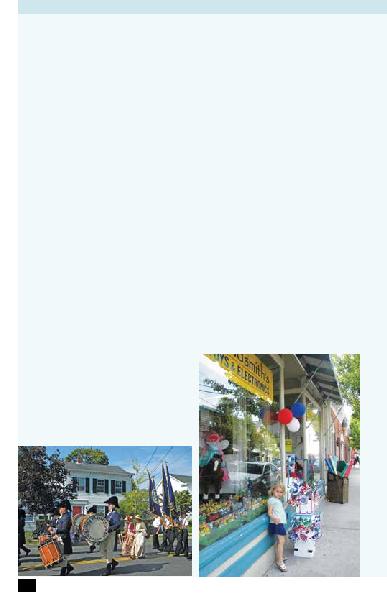
12
Greenport
12
Greenport
speak of, and suffered from poverty, high
unemployment and run-down real estate. It
wasn't all that attractive to outsiders, except
for a sprinkling of artists, writers and other
brave souls who liked the low rent and gritty,
"undiscovered" vibe.
Greenport's transformation began with
the vision of a spacious park built on an old,
polluted commercial waterfront site. Mitchell
Park, a $20 million federal, state and local
project that includes the 1920's Grumman car-
ousel, an ice rink, amphitheater, and adjoin-
ing marina, is the key to Greenport's success,
said former mayor Dave Kapell, who led the
village from 1994 to 2007, and initiated the
project. It opened in 2005, and a new Green-
port was ready to welcome back the crowds.
The park's stunning modern design was
the first big project by the now-renowned
architectural fi rm ShoP, and is a landmark in
its own right. But, Kapell said, the park's real
magic lies in the visitors it attracts.
"The park sends a message that Greenport
is a family friendly place," said Kapell.
At the same time, the growing North Fork
wine industry enticed more visitors to the
area, and these people found that Greenport
was a great place to add to their itinerary.
Yet, for all its success, Greenport has avoid-
ed becoming a cliché - a faux-maritime back-
drop for chain retail shops that are found in
every tourist destinations. Nor is it becoming
"another Hampton." Greenport is real, and
still a little rough around the edges. Most of
the shops, restaurants and art galleries are
locally owned and operated, and the eclec-
tic, even quirky mix of taste and styles is as
diverse as the owners themselves. While they
thrive in the summer and fall, it's a precarious
existence in the winter, a testament to the
business community's deep and genuine com-
mitment to Greenport.
But even that is changing: Greenport now
has a sizeable group of second home-owners
who live in New York City/western Long
Island and come out on weekends all year
round. And the year-round population of
families and retirees is also growing.
"Greenport is one of our hottest areas right
now," said Carol Tintle, with real estate fi rm
Daniel Gale Sotheby's offi ce on Main Street.
"There's a lot of interest. People are looking
for weekend homes; usually they come out
and rent for a week or two, and then decide
that they want to buy." People like Green-
port's mix of rural and sophisticated, the
access to fi ne dining and shopping, the way
they don't have to bring a car; they can walk
to the supermarket or the farmer's market,
and to a restaurant in the evening. One of
Greenport's main charms is its historic archi-
tecture. Take a walk up Main Street through
the designated Historic District, and you will
see well-maintained Victorians and Federal
style houses with a few here and there that
could still use some TLC.
Signs point to this being a great time to
buy. While prices are holding, with the medi-
an home price just below $300,000, the num-
ber of units sold in Greenport annually has
been on the rise. Older homes, from ornate
Victorians dating from the 1880s, through the
turn of the last century up until about 1940s
are especially in demand. "People love the
historic houses," said Tintle. "They always
ask to see those fi rst."
For Greenport, fair skies are ahead, and all
signs point to smooth sailing.

